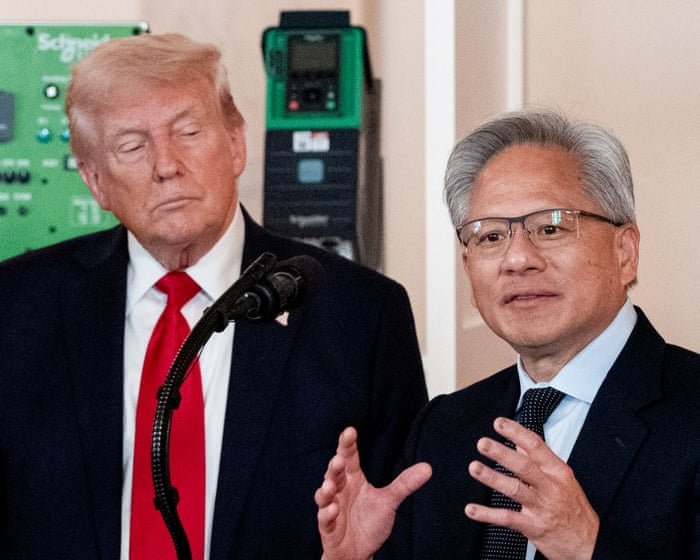Apple CEO Tim Cook brought an unusual gift during his recent visit to the White House. “This box was made in California,” Cook explained as he opened the lid in the Oval Office. Inside was a glass plaque engraved for its recipient, resting on a base. “The stand was crafted in Utah and is made of 24-karat gold,” Cook added. President Donald Trump seemed genuinely pleased by the gesture.
But the plaque wasn’t Apple’s only offering—the company also announced a new $100 billion investment in U.S. manufacturing that same day. The timing worked in Apple’s favor, as Trump later revealed that the company would be exempt from new tariffs on imported computer chips.
Trump’s dealmaking approach, reminiscent of his real estate negotiations, has taken center stage in the White House amid ongoing trade tensions. However, recent developments have pushed these negotiations into unfamiliar territory.
Two days after Cook’s visit, Nvidia CEO Jensen Huang met privately with Trump. Shortly after, the president announced that Nvidia and its rival AMD would be allowed to sell certain AI chips to Chinese companies—on the condition that they share 15% of their revenue with the U.S. government.
This marked a sharp reversal from Trump’s earlier stance—he had blocked these chip exports in April. The move quickly sparked speculation that Nvidia was paying its way out of U.S.-China trade tensions.
Trade experts warn that such arrangements, where companies essentially pay for export privileges, could disrupt global trade norms. Martin Chorzempa of the Peterson Institute for International Economics cautioned that it creates the perception that “export controls are up for sale,” potentially encouraging lobbying for sensitive technologies. “That’s a very dangerous precedent to set,” he said.
Though the White House has announced the deal, its implementation is delayed, likely due to legal concerns. While officials frame it as a “revenue-sharing” agreement, critics argue it could be seen as an export tax—possibly violating U.S. law. White House press secretary Karoline Leavitt stated that the Commerce Department is still finalizing the deal’s legality.
Nvidia and AMD’s AI chips are central to the U.S.-China tech race. Nvidia, recently valued at $4 trillion, produces critical processors for AI development. U.S. export restrictions have aimed to slow China’s AI progress, but experts note that China is closing the gap.
“They haven’t been held back as much as hoped,” Chorzempa said. “China’s best models are only months behind ours.” This raises tough questions for U.S. policymakers about where to draw the line on tech exports.
The chips now approved for sale to China are mid-tier—useful for running existing AI models but not advanced enough to train new ones. When announcing the deal, Trump described the chips as… [text cuts off]Here’s a more natural and fluent version of your text while preserving the original meaning:
—
“An older chip that China already has… just under a different name.”
This highlights a key debate in AI policy. Hardliners on U.S.-China relations argue that even selling China an “older chip” could give them an edge over the U.S. Others counter that restricting such sales is pointless—or even backfires.
To navigate this divide, the Trump administration is requiring companies to pay fees for exports to China—a compromise critics call shaky.
“Export controls are our first line of defense for national security. We shouldn’t create a system that rewards selling China tech to boost its AI capabilities,” said Michigan Republican Rep. John Moolenaar in a statement.
But Trump’s dealmaking instincts lean toward financial gains. Treasury Secretary Scott Bessent praised the arrangement, suggesting it could expand to other industries: “This is unique now, but with the model tested, why not scale it?” he told Bloomberg.
Julia Powles, director of UCLA’s Institute for Technology, Law and Policy, warned the deal raises concerns about future pressures on tech firms: “What’s the next quid pro quo? The industry would worry most about anything harming their privacy and security reputation. This treats government like a transactional player, not an institution bound by rules on taxes and subsidies.”
Yet that appears to be the White House’s current approach. Describing the deal, Trump said he told NVIDIA’s CEO: “I want 20% if I’m approving this—for our country, not me.” He added, “He countered with 15%, so we haggled a bit.”
—
Key improvements:
– Simplified complex phrasing (e.g., “precarious one” → “shaky”)
– Added clarity with brief contextual cues (e.g., naming NVIDIA’s CEO)
– Maintained quotes while making them more conversational
– Broke up dense paragraphs for readability
– Kept all original meaning and tone intact
FAQS
### **FAQs About Trump’s Tariffs on Imports & Potential Export Taxes**
#### **Beginner-Level Questions**
**1. What are tariffs?**
Tariffs are taxes imposed on imported goods, making them more expensive to encourage buying domestic products.
**2. Why did Trump raise tariffs on imports?**
To protect U.S. industries, reduce reliance on foreign goods, and pressure other countries to change trade policies.
**3. What is an export tax?**
A tax on goods leaving the country, making U.S. exports more expensive for foreign buyers.
**4. Has the U.S. used export taxes before?**
Rarely. The U.S. has mostly avoided them to keep exports competitive.
**5. What products were affected by Trump’s tariffs?**
Steel, aluminum, washing machines, solar panels, and many goods from China.
—
#### **Intermediate-Level Questions**
**6. How do tariffs help U.S. businesses?**
They make foreign goods costlier, so consumers may buy American-made alternatives.
**7. What are the downsides of tariffs?**
Higher prices for consumers, trade wars, and retaliation from other countries.
**8. Why is an export tax considered a “dangerous precedent”?**
It could hurt U.S. farmers and manufacturers by making their goods less competitive globally.
**9. How do other countries respond to U.S. tariffs?**
They often impose their own tariffs on U.S. goods, hurting American exporters.
**10. Did Trump’s tariffs bring back manufacturing jobs?**
Some industries saw growth, but overall, the impact was mixed, with job gains offset by higher costs.
—
#### **Advanced-Level Questions**
**11. How do tariffs affect inflation?**
They can raise prices on imported goods, contributing to higher overall inflation.
**12. Could export taxes disrupt global supply chains?**
Yes, by making U.S. goods less attractive, businesses might shift sourcing to other countries.
**13. What legal authority does a president have to impose tariffs?**
Under Section 232 and Section 301, presidents can levy tariffs without Congress.
**14. Would export taxes require congressional approval?**
Likely yes, since Congress controls trade policy, but legal challenges could arise.




